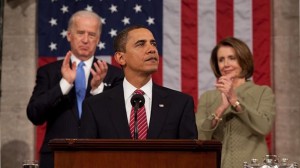
Is Obama’s auto vision a mere academic dream or actually production possible?
In what some observers are calling this year’s real “state of the union,” President Barak Obama challenged Congress and the country to join in a national recovery effort. While he covered many areas as he ranged from criticizing the nation for short-term thinking to trying to inspire a collective effort, several of the president’s points bear on the auto industry. One of these was indeed a finger directly pointed at auto makers, or at least some of them.
“As for our auto industry, everyone recognizes that years of bad decision-making and a global recession have pushed our auto makers to the brink,” the president says. While noting that government should not “protect [auto makers] from their own bad practices,” Obama commits his administration to “the goal of a re-tooled, re-imagined auto industry that can compete and win.”
The president proposes no new obligations particular to the industry, but his broader theme of energy suggests an opening for auto makers to help shape the new administration’s program in a way that could help them more than existing U.S. energy policy has to date.
In addition to the fiscal necessities of recovery and debt reduction, Obama highlighted what he called “the three big areas that are absolutely critical to our economic future: energy, health care, and education.”
He went on to say, “It begins with energy.” His energy plans include rapidly doubling the supply of renewable energy, making large, new investments in basic research, strengthening the power grid and financing energy-efficiency improvements in homes and other buildings.
Where real opportunity exists for auto makers is in Obama’s call for Congress to pass “legislation that places a market-based cap on carbon pollution and drives the production of more renewable energy in America.”
How does that help the industry, one might ask?
Two ways come to mind, only one of which the president mentioned. The most obvious is using revenues from a cap-and-trade program to directly fund new technology. As Obama said, “to support that innovation, we will invest fifteen billion dollars a year to develop technologies like wind power and solar power; advanced biofuels, clean coal, and more fuel-efficient cars and trucks built right here in America.”
However, direct federal dollars can only go but so far. Only part of the promised $15 billion will end up in the auto sector, a sector that when it’s hitting on all cylinders represents a more than $400 billion national market.
What the president didn’t directly mention is another key aspect of carbon cap policy, namely, the sustained price signal it will provide by embedding the cost of carbon in the price of fuel. That part of the policy follows from the fact that a carbon cap would obligate the petroleum industry to finally share the burden of reducing emissions.
Throughout industry circles, from auto makers themselves to leading dealer executives like AutoNation’s Mike Jackson, the fall in gasoline prices has provoked calls for higher fuel taxes. Such a price signal is seen as crucial for keeping consumers motivated to buy the fuel-efficient vehicles that policymakers are mandating the industry to build. A tax itself, however, is a tough sell, and we’re certainly not hearing the president calling for it.
A national climate policy, however, will provide a similar price signal in the form of regulation of the oil industry under the carbon cap. Some auto pundits might wish to second-guess Obama’s strategy and press for a tax head on (funny thing about it, the head of ExxonMobil is also calling for a tax on consumers as better than regulating his industry). But perhaps the time is right for auto makers to take up the president’s unspoken challenge of helping him enact a policy that for the first time in history would share the task of reducing fuel use and emissions broadly instead of leaving auto makers themselves as the sole target in Congress’s sights.
